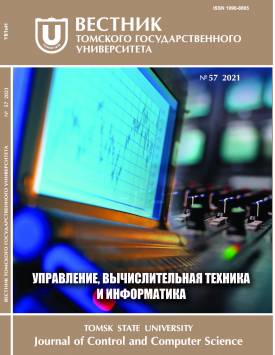The effectiveness of forward error correction in transport protocol at the intrasegment level
A mathematical model of a transport connection controlled by a reliable transport protocol with forward error correction in the form of a Markov chain with discrete time is considered, taking into account the influence of protocol parameters, transmission reliability, round trip delay and FEC parameters on the throughput of the transport connection. An analysis of the dependence of the advantages of using forward error correction over the classical transport protocol was carried out.
Keywords
transport protocol,
forward error correction,
Markov chain,
bandwidth,
loss rateAuthors
| Pristupa Pavel V. | Tomsk State University | pristupa@gmail.com |
| Mikheev Pavel A. | Tomsk State University | doka.patrick@gmail.com |
| Poddubnyy Vasiliy V. | Tomsk State University | vvpoddubny@gmail.com |
| Suschenko Sergey P. | Tomsk State University | ssp.inf.tsu@gmail.com |
Всего: 4
References
Fall K., Stevens R. TCP/IP Illustrated. 2nd ed. Addison-Wesley Professional, 2012. V. 1: The Protocols. 1017 p. (Addison-Wesley Professional Computing Series).
Kokshenev V.V., Mikheev P.A., Sushchenko S.P.Comparative Analysis of the Performance of Selective and Group Repeat Transmission Models in a Transport Protocol // Automation and Remote Control. 2017. V. 78, № 2. P. 247-261.
Kokshenev V., Mikheev P., Suschenko S., Tkachyov R. Analysis of the Throughput in Selective Mode of Transport Protocol // Communications in Computer and Information Science. 2016. V. 678. P. 168-181.
Bogushevsky D., Mikheev P., Pristupa P., Suschenko S. The Time-Out Length Influence on the Available Bandwidth of the Selec tive Failure Mode of Transport Protocol in the Load Data Transmission Path // Communications in Computer and Information Science. 2018. V. 919. P. 120-131.
Kassa D.F. Analytic Models of TCP Performance : PhD Thesis / University of Stellenbosch. 2005. 199 p.
Giordano S., Pagano M., Russo F., Secchi R. Modeling TCP Startup Performance // Journal of Mathematical Sciences. 2014. V. 200, is. 4. P. 424-431.
Kravets O.Ya. Mathematical Modeling of Parameterized TCP Protocol // Automation and Remote Control. 2013. V. 74, № 7. P. 1218-1224.
Arvidsson A., Krzesinski A. A model of a TCP link // Proc. of the 15th International Teletraffic Congress Specialist Seminar. 2002.
Olsen Y. Stochastic modeling and simulation of the TCP protocol // Uppsala Dissertations in Mathematics. 2003. V. 28. 94 p.
Mikheev P., Pristupa P., Suschenko S. Performance of Transport Connection with Selective Failure Mode When Competing for Throughput of Data Transmission Path // Communications in Computer and Information Science. 2019. V. 1141. P. 89-103.
Nikitinskiy M.A., Chalyy D.Ju. Performance analysis of trickles and TCP transport protocols under high-load network conditions // Automatic Control and Computer Sciences. 2013. V. 47, № 7. P. 359-365.
Langley A., Riddoch A., Wilk A., Vicente A., Krasic C., Zhang D., Yang F., Kouranov F., Swett I., Iyengar J., Bailey J., Dorf-man J., Roskind J., Kulik J., Westin P., Tenneti R., Shade R., Hamilton R., Vasiliev V., Chang W.T., Shi Z. The QUIC Transport Protocol: Design and Internet-Scale Deployment // SIGCOMM’17, August, 2017, Los Angeles, CA, USA. P. 183-196.
Lundqvist H., Karlsson G. TCP with end-to-end FEC // International Zurich Seminar on Communications. 2004. P. 152-156.
Barakat Ch., Altman E. Bandwidth tradeoff between TCP and link-level FEC // Computer Networks. 2002. № 39. P. 133-150.
Shalin R., Kesavaraja D. Multimedia Data Transmission through TCP/IP using Hash Based FEC with AUTO-XOR Scheme // ICTACT Journal on Communication Technology. 2012. V. 03, is. 03. P. 604-609.
Ribadeneir A.F. An Analysis of the MOS under condition of delay, jitter and packet loss and an analysis of the impact of introducing piggybacking and Reed Solomon FEC for VOIP : Master’s thesis/ Georgia State University. 2007.
Matsuzono K., Detchart J., Cunche M., Roca V., Asaeda H. Performance analysis of a high-performance real-time application with several al-fec schemes // Proceedings of the IEEE 35th Conference on Local Computer Networks, LCN’10. 2010. P. 1-7.
Herrero R. Modeling and comparative analysis of Forward Error Correction in the context of multipath redundancy // Telecommunication Systems. Modelling, Analysis, Design and Management. 2017. V. 65 (4). P. 783-794.
Mikheev P., Suschenko S., Tkachev R. Estimation of High-Speed Performance of the Transport Protocol with the Mechanism of Forward Error Correction // Communications in Computer and Information Science. 2017. V. 700. P. 259-268.
Francois M., De Coninck Q., Bonaventure O. QUIC-FEC: Bringing the benefits of Forward Erasure Correction to QUIC // arXiv: 1904.11326v1 [cs.NI]. 25 Apr. 2019. P. 1-9.

